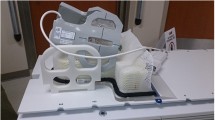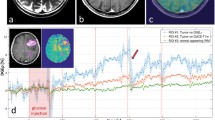Abstract
Objectives
This study aims to evaluate the feasibility of imaging breast cancer with glucosamine (GlcN) chemical exchange saturation transfer (CEST) MRI technique to distinguish between tumor and surrounding tissue, compared to the conventional MRI method.
Methods
Twelve patients with newly diagnosed breast tumors (median age, 53 years) were recruited in this prospective IRB-approved study, between August 2019 and March 2020. Informed consent was obtained from all patients. All MRI measurements were performed on a 3-T clinical MRI scanner. For CEST imaging, a fat-suppressed 3D RF-spoiled gradient echo sequence with saturation pulse train was applied. CEST signals were quantified in the tumor and in the surrounding tissue based on magnetization transfer ratio asymmetry (MTRasym) and a multi-Gaussian fitting.
Results
GlcN CEST MRI revealed higher signal intensities in the tumor tissue compared to the surrounding breast tissue (MTRasym effect of 8.12 ± 4.09%, N = 12, p = 2.2 E−03) with the incremental increase due to GlcN uptake of 3.41 ± 0.79% (N = 12, p = 2.2 E−03), which is in line with tumor location as demonstrated by T1W and T2W MRI. GlcN CEST spectra comprise distinct peaks corresponding to proton exchange between free water and hydroxyl and amide/amine groups, and relayed nuclear Overhauser enhancement (NOE) from aliphatic groups, all yielded larger CEST integrals in the tumor tissue after GlcN uptake by an averaged factor of 2.2 ± 1.2 (p = 3.38 E−03), 1.4 ± 0.4 (p =9.88 E−03), and 1.6 ± 0.6 (p = 2.09 E−02), respectively.
Conclusion
The results of this initial feasibility study indicate the potential of GlcN CEST MRI to diagnose breast cancer in a clinical setup.
Key Points
• GlcN CEST MRI method is demonstrated for its the ability to differentiate between breast tumor lesions and the surrounding tissue, based on the differential accumulation of the GlcN in the tumors.
• GlcN CEST imaging may be used to identify metabolic active malignant breast tumors without using a Gd contrast agent.
• The GlcN CEST MRI method may be considered for use in a clinical setup for breast cancer detection and should be tested as a complementary method to conventional clinical MRI methods.




Similar content being viewed by others
Abbreviations
- CEST:
-
Chemical exchange saturation transfer
- Gd:
-
Gadolinium
- GlcN:
-
Glucosamine
- MRI:
-
Magnetic resonance imaging
- MT:
-
Magnetization transfer
- MTRasym:
-
Magnetization transfer ratio asymmetry
- NOE:
-
Nuclear Overhauser enhancement
- ROI:
-
Region of interest
- T1W:
-
T1-weighted
- T2W:
-
T2-weighted
References
Ward KM, Aletras AH, Balaban RS (2000) A new class of contrast agents for MRI based on proton chemical exchange dependent saturation transfer (CEST). J Magn Reson 143:79–87
Vinogradov E, Sherry AD, Lenkinski RE (2013) CEST: from basic principles to applications, challenges and opportunities. J Magn Reson 229:155–172
Wu B, Warnock G, Zaiss M et al (2016) An overview of CEST MRI for non-MR physicists. EJNMMI Phys 3:016–0155
Togao O, Yoshiura T, Keupp J et al (2014) Amide proton transfer imaging of adult diffuse gliomas: correlation with histopathological grades. Neuro Oncol 16:441–448
Takayama Y, Nishie A, Togao O et al (2018) Amide proton transfer MR imaging of endometrioid endometrial adenocarcinoma: association with histologic grade. Radiology 286:909–917
Meissner J-E, Korzowski A, Regnery S et al (2019) Early response assessment of glioma patients to definitive chemoradiotherapy using chemical exchange saturation transfer imaging at 7 T. J Magn Reson Imaging 50:1268–1277
Chan KW, Jiang L, Cheng M et al (2016) CEST-MRI detects metabolite levels altered by breast cancer cell aggressiveness and chemotherapy response. NMR Biomed 29:806–816
Krikken E, van der Kemp WJM, Khlebnikov V et al (2019) Contradiction between amide-CEST signal and pH in breast cancer explained with metabolic MRI. NMR Biomed 32:e4110
Zhang S, Seiler S, Wang X et al (2018) CEST-Dixon for human breast lesion characterization at 3 T: a preliminary study. Magn Reson Med 80:895–903
Klomp DWJ, Dula AN, Arlinghaus LR et al (2013) Amide proton transfer imaging of the human breast at 7T: development and reproducibility. NMR Biomed 26:1271–1277
Chan KWY, McMahon MT, Kato Y et al (2012) Natural D-glucose as a biodegradable MRI contrast agent for detecting cancer. Magn Reson Med 68:1764–1773
Longo DL, Moustaghfir FZ, Zerbo A et al (2017) EXCI-CEST: exploiting pharmaceutical excipients as MRI-CEST contrast agents for tumor imaging. Intern J Pharma 525:275–281
Anderson JW, Nicolosi RJ, Borzelleca JF (2005) Glucosamine effects in humans: a review of effects on glucose metabolism, side effects, safety considerations and efficacy. Food Chem Toxicol 43:187–201
Barron CC, Bilan PJ, Tsakiridis T, Tsiani E (2016) Facilitative glucose transporters: implications for cancer detection, prognosis and treatment. Metabolism 65:124–139
Rivlin M, Navon G (2016) Glucosamine and N-acetyl glucosamine as new CEST MRI agents for molecular imaging of tumors. Sci Rep 6:32648–32648
Rivlin M, Navon G (2021) Molecular imaging of cancer by glucosamine chemical exchange saturation transfer MRI: a preclinical study. NMR Biomed 34:e4431
Rivlin M, Barazany D, Navon G (2018) Chemical exchange saturation transfer (CEST) MRI of glucosamine at 3T. Proc Intl Soc Mag Reson Med 26:2275
Poblador Rodriguez E, Moser P, Dymerska B et al (2019) A comparison of static and dynamic ∆B(0) mapping methods for correction of CEST MRI in the presence of temporal B(0) field variations. Magn Reson Med 82:633–646
Stancanello J, Terreno E, Castelli DD, Cabella C, Uggeri F, Aime S (2008) Development and validation of a smoothing-splines-based correction method for improving the analysis of CEST-MR images. Contrast Media Mol Imaging 3:136–149
Zaiss M, Schmitt B, Bachert P (2011) Quantitative separation of CEST effect from magnetization transfer and spillover effects by Lorentzian-line-fit analysis of z-spectra. J Magn Reson 211:149–155
Zhang L, Zhao Y, Chen Y et al (2019) Voxel-wise Optimization of Pseudo Voigt Profile (VOPVP) for Z-spectra fitting in chemical exchange saturation transfer (CEST) MRI. Quant Imaging Med Surg 9(10):1714–1730
Rivlin M, Navon G (2018) CEST MRI of 3-O-methyl-D-glucose on different breast cancer models. Magn Reson Med 79:1061–1069
Zhou IY, Wang E, Cheung JS, Zhang X, Fulci G, Sun PZ (2017) Quantitative chemical exchange saturation transfer (CEST) MRI of glioma using Image Downsampling Expedited Adaptive Least-squares (IDEAL) fitting. Sci Rep 7:017–00167
Jackson CG, Plaas AH, Sandy JD et al (2010) The human pharmacokinetics of oral ingestion of glucosamine and chondroitin sulfate taken separately or in combination. Osteoarthritis Cartilage 18:297–302
Sherry AD, Caravan P, Lenkinski RE (2009) Primer on gadolinium chemistry. J Magn Reson Imaging 30:1240–1248
Acknowledgements
We are indebted to the patients who participated in this research and we gratefully acknowledge Dr. Ilana Haas and Dr. Ravit Agassi for assisting in their recruitment.
Funding
The authors gratefully acknowledge the support of this research by the Earlier.org - Friends For an Earlier Breast Cancer Test foundation and the Israel Science Foundation.
Author information
Authors and Affiliations
Corresponding author
Ethics declarations
Ethics approval
Institutional Review Board approval was obtained.
Informed consent
Written informed consent was obtained from all subjects (patients) in this study.
Conflict of interest
The authors of this manuscript declare no relationships with any companies, whose products or services may be related to the subject matter of the article.
Guarantor
The scientific guarantor of this publication is Prof. Gil Navon.
Statistics and biometry
No complex statistical methods were necessary for this paper.
Methodology
• prospective
• diagnostic or prognostic study
• performed at one institution
Additional information
Publisher’s note
Springer Nature remains neutral with regard to jurisdictional claims in published maps and institutional affiliations.
Supplementary information
ESM 1
(DOCX 176 kb)
Rights and permissions
About this article
Cite this article
Rivlin, M., Anaby, D., Nissan, N. et al. Breast cancer imaging with glucosamine CEST (chemical exchange saturation transfer) MRI: first human experience. Eur Radiol 32, 7365–7373 (2022). https://doi.org/10.1007/s00330-022-08772-w
Received:
Revised:
Accepted:
Published:
Issue Date:
DOI: https://doi.org/10.1007/s00330-022-08772-w




